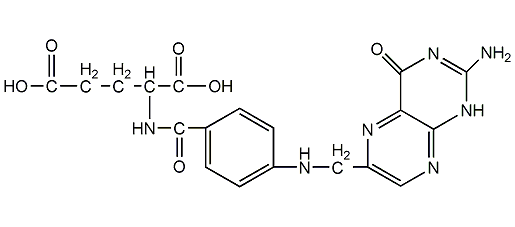
structural formula
| business number | 01a9 |
|---|---|
| molecular formula | c19h19n7o6 |
| molecular weight | 441.4 |
| label |
n-[4-[(2-amino-4-oxo-1,4-dihydro-6-pteridine)methylamino]benzoyl]-l-glutamic acid, pteglu, pteroyl-l-glutamic acid, nutrition supplements |
numbering system
cas number:59-30-3
mdl number:mfcd00079305
einecs number:200-419-0
rtecs number:lp5425000
brn number:100781
pubchem number:24894950
physical property data
1. properties: light orange-yellow crystals or flakes.
2. density (g/ml, 25/4℃): undetermined
3. relative vapor density (g/ml, air=1): undetermined
4. melting point (ºc): no melting point, color becomes darker and carbonized at about 250℃.
5. boiling point (ºc, normal pressure): undetermined
6. boiling point (ºc, 3.52kpa): undetermined
7. refractive index: undetermined
8. flash point (ºc): undetermined
9. specific rotation (º): [α]d25 +23° (c=0.5, in 0.1mol/l sodium hydroxide solution)
10. autoignition point or ignition temperature (ºc): undetermined
11. vapor pressure (kpa, 25ºc): not determined
12. saturation vapor pressure (kpa, 60ºc): not determined
13. heat of combustion (kj/mol): not determined determined
14. critical temperature (ºc): undetermined
15. critical pressure (kpa): undetermined
16. oil and water (octanol/water ) log value of distribution coefficient: undetermined
17. explosion upper limit (%, v/v): undetermined
18. explosion lower limit (%, v/v): undetermined determine
19. solubility: soluble in hot dilute hydrochloric acid and sulfuric acid, slightly soluble in acetic acid, phenol, pyridine, alkali hydroxide and alkali carbonate solutions, slightly soluble in ethanol and butanol, slightly soluble in methanol is very slightly soluble in cold water (25°c, 0.0016 mg/ml), about 1% soluble in boiling water, and insoluble in ether, acetone, chloroform and benzene. suspension of 1g folic acid in 10ml water, ph 4.0~4.8. the ph of the solution prepared with sodium bicarbonate is 6.5 to 6.8.
toxicological data
1. acute toxicity: rat intravenous ld50: 500mg/kg; mouse oral ld50: 10mg/kg; mouse intraperitoneal ld50: 85mg/kg; mouse subcutaneous ldlo: 200mg/kg; mouse intravenous ld50: 282mg/kg ; mouse subcutaneous ld50: 200mg/kg; rabbit intravenous ldlo: 410mg/kg; guinea pig intravenous ld50: 120mg/kg 2. reproductive toxicity: female rat parenteral tdlo: 150mg/kg, 10 days after conception 3. mutagenicity: dna synthesis: rat abdominal cavity: 150mg/kg; cytogenetic analysistest system�: rodents – rat lymphocytes: 10ug/l; dna synthesis: mouse subcutaneous: 150mg/kg; dna synthesis: mouse abdominal cavity: 250mg/kg
ecological data
none yet
molecular structure data
1. molar refractive index: 44.06
2. molar volume (cm3/mol): 115.2
3. isotonic specific volume (90.2k): 320.2
4. surface tension (dyne/cm): 59.7
5. polarizability (10-24cm3): 17.47
compute chemical data
1. reference value for calculation of hydrophobic parameters (xlogp): -1.1
2. number of hydrogen bond donors: 6
3. number of hydrogen bond acceptors: 9
4. number of rotatable chemical bonds: 9
5. number of tautomers: 60
6. topological molecule polar surface area 209
7. number of heavy atoms: 32
8. surface charge: 0
9. complexity: 767
10. number of isotope atoms: 0
11. determine the number of atomic stereocenters: 1
12. uncertain number of atomic stereocenters: 0
13. determine the number of chemical bond stereocenters: 0
14. number of uncertain chemical bond stereocenters: 0
15. number of covalent bond units: 1
properties and stability
toxic or corrosive substances such as thionyl chloride are used in the production process. the equipment should be sealed, the workshop should be well ventilated, and the operators should wear labor protection supplies.
storage method
this product should be sealed and stored in a dry place at 4°c away from light. seal the package and store it away from light.
synthesis method
1. folic acid was originally extracted from liver extract and is now produced synthetically. the synthesis method can first synthesize the pteridine core, and then condense it with p-aminobenzoylglutamic acid to obtain folic acid, or it can also be synthesized from 2,4,5-triamino-6-hydroxypyrimidine, α,β-dibromopropionaldehyde and p-aminobenzoylglutamic acid. benzoylglutamic acid reacts in acetic acid-sodium acetate buffer solution to obtain crude folic acid, which is refined to obtain folic acid containing two molecules of crystal water. similar to the latter synthesis method, p-aminobenzoylglutamic acid, trichloroacetone and 2,4,5-triamino-6-hydroxypyrimidine sulfate ([1603-20-7]) were prepared in sodium acetate and pyrolysis in the presence of sodium sulfite, keep the ph at 3.4-3.6 and the temperature at 36-40°c, perform a cyclization reaction for 6 hours to obtain orange-red folic acid precipitation.
2.composed of 2,4,5-triamino-6-hydroxypyrimidine, p-aminobenzoylglutamic acid and trichloroacetone in it is prepared by cyclization reaction in the presence of sodium acetateand sodium metabisulfite.
3.2,4,5-triamino-6-hydroxypyrimidine and p-aminoylglutamine add the ethanol solution of α,β-dibromopropionaldehyde to the acid aqueous solution to condense it to obtain a crude product, which can be refined.
purpose
1. biochemical research. medicine. anti-anemic drugs, used for symptomatic or nutritional giant cell anemia. it is also widely used in feed, medicine and food. 2.used as food fortifier. when folic acid is lacking, dna synthesis is bound to be inhibited, dna synthesis in bone marrow red blood cells is reduced, cell division speed is reduced, and cell volume becomes larger. mild folate deficiency can lead to depression, while severe folate deficiency can lead to megaloblastic anemia. it can be used in food for infants and young children at a dosage of 380 to 700 μg/kg; in food for pregnant women and lactating mothers, it is 2 to 4 mg/kg.

 微信扫一扫打赏
微信扫一扫打赏

